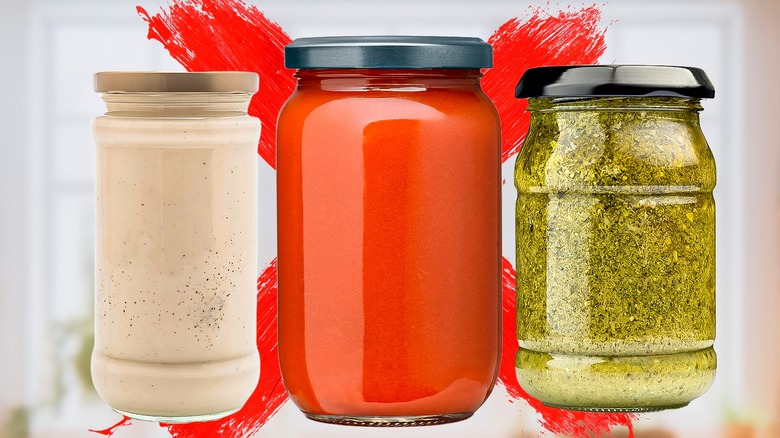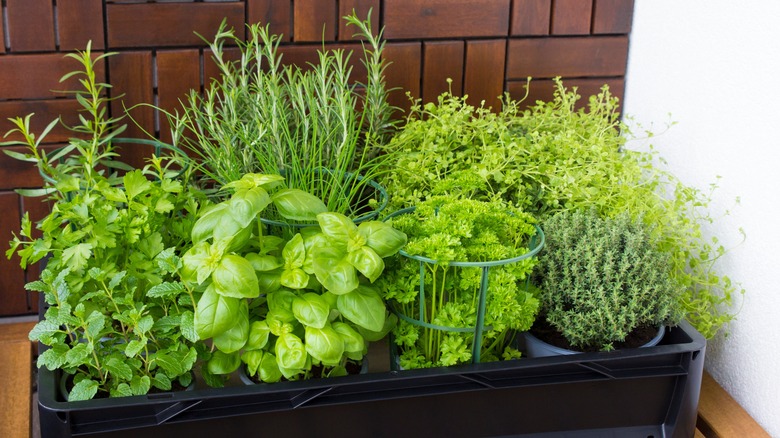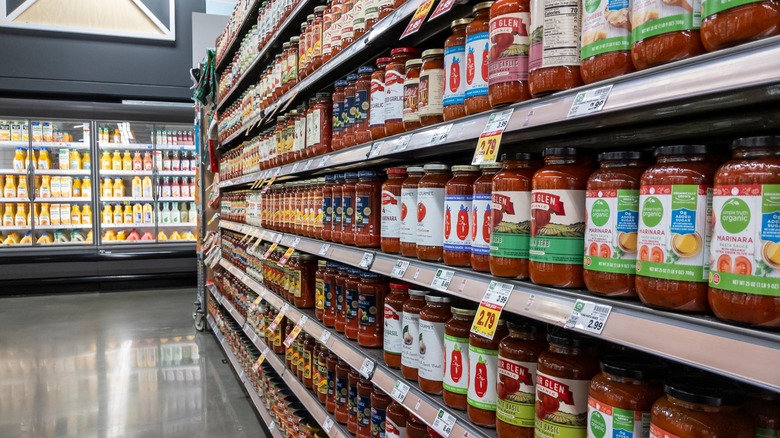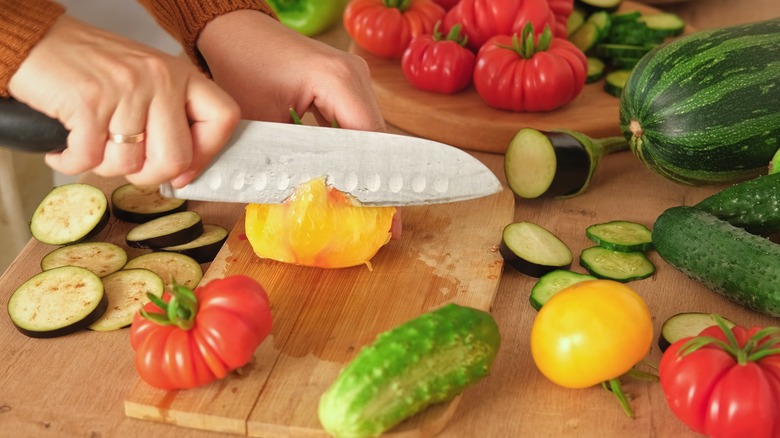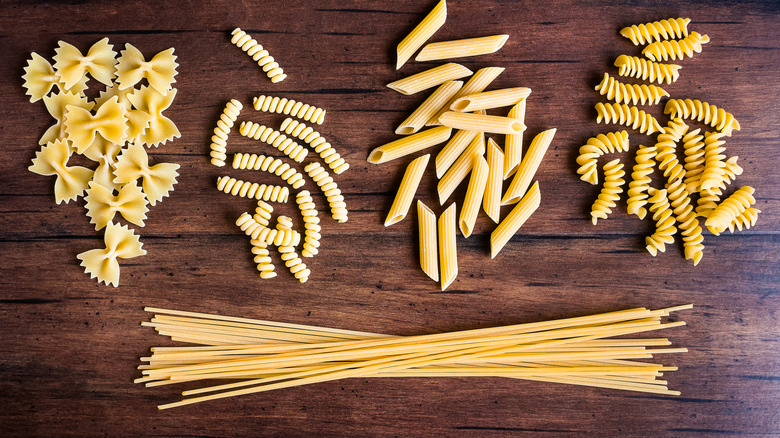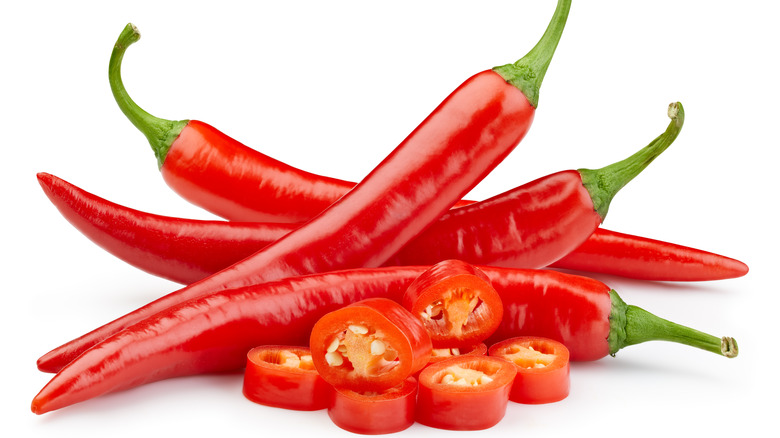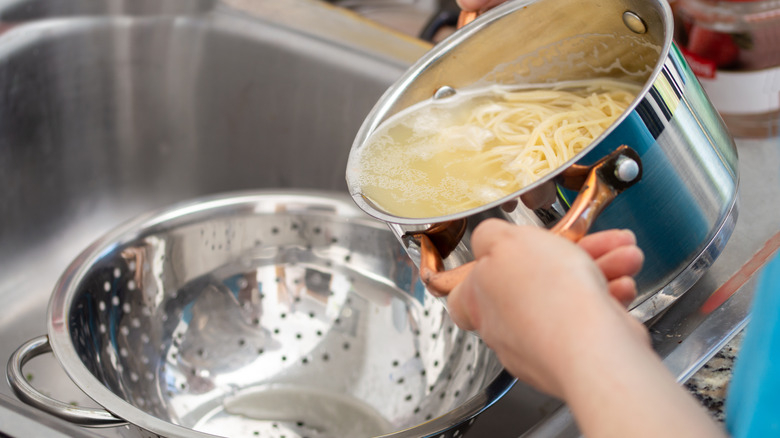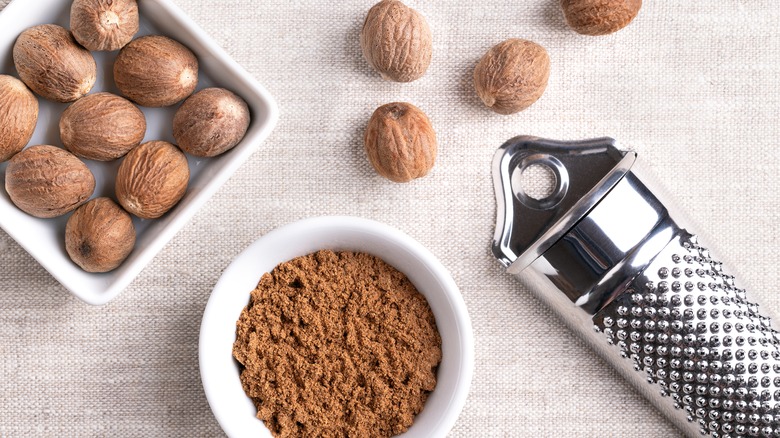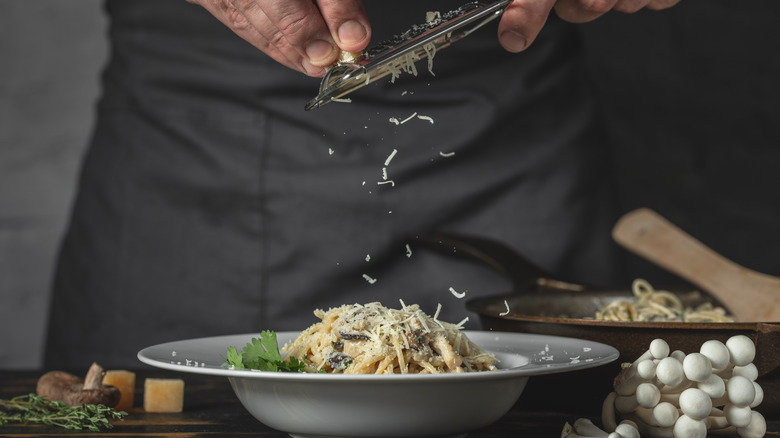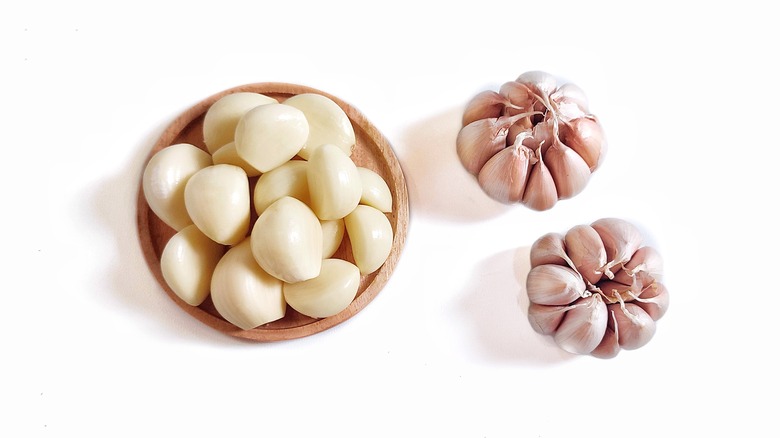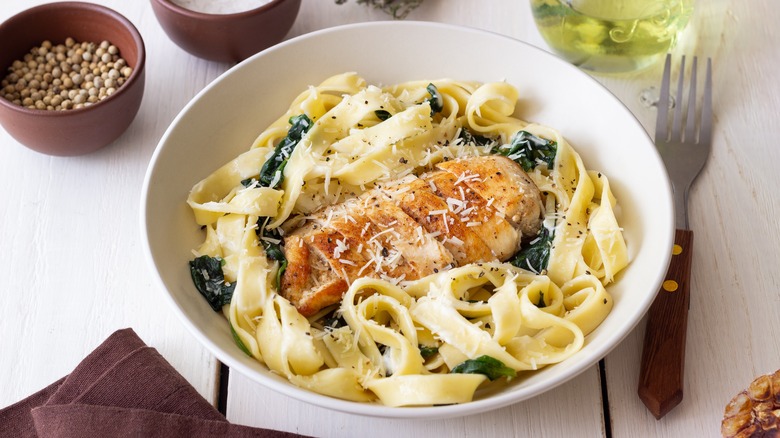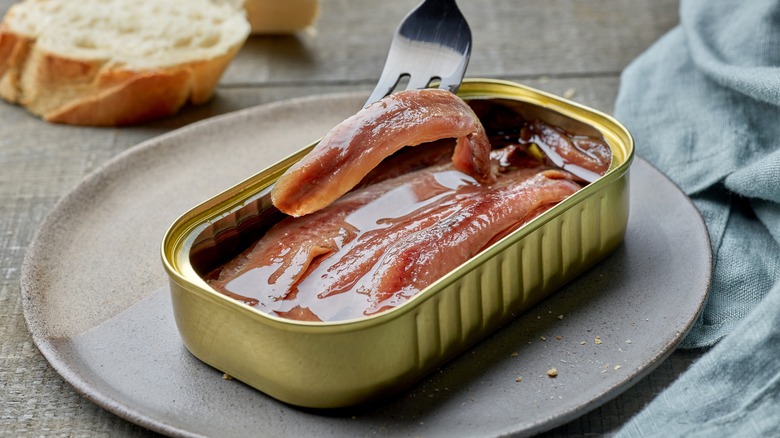12 Biggest Mistakes You're Making With Jarred Pasta Sauce
As a keen home cook, you probably prefer to make everything from scratch and prepare hearty, homemade food for yourself or your family. In reality, however, life can get in the way. In our modern, hectic lives, sometimes there just aren't enough minutes to do the type of cooking we would like. This is where a jar of pasta sauce can come to the rescue. Being able to whip up a filling meal in the time it takes to boil some noodles can be a lifesaver. But if you're used to cooking your own sauce, the store-bought version can feel like it lacks the vibrancy of the homemade version.
There may be a few vital mistakes you're making when cooking with jarred pasta sauce that can be the difference between an average midweek meal and a delicious homemade feast. From not adding fresh herbs to tossing all of the starchy pasta water, remedying a few of these mistakes will help up your pasta game on days when a shortcut sauce is needed. So, let's take a look at the 12 biggest mistakes you may be making with jarred pasta sauce and the simple ways to fix them.
Failing to add fresh herbs
One of the aspects of a fresh sauce that the jarred version can't quite capture is the aromatic quality that fresh herbs can bring. It is possible that your jar of sauce had herbs added during manufacturing, but the chances of the fragrant flavor surviving until you open the jar are unlikely. The flavor molecules in fresh herbs are easily destroyed, so incorporating extra before adding to your pasta will make a big difference.
The herbs you choose to add will depend on what type of sauce you are using. Basil is a great all-round option that captures the essence of Italian cuisine and will complement any sauce. Be sure to hand-tear your basil instead of chopping it, which can bruise the leaves and diminish the flavor. Add a few whole leaves on top as a vibrant garnish.
Fresh oregano is excellent for elevating a jar of Bolognese. Most home cooks have dried oregano in the spice rack, but the fresh version is in another league, creating a depth of flavor that the jar is missing.
Alfredo sauce, on the other hand, will benefit from a burst of freshness from some parsley — its earthy and slightly peppery notes give some much-needed variation to the creamy flavor. Other than lifting the flavor of the sauce, the fresh herbs will give a pop of color to the pasta dish, enhancing the presentation and making it look homemade.
Choosing a low-quality jar of sauce
As a superstar in the kitchen, you know that everything tastes better homemade, but sometimes that jar of pasta sauce at the back of the cupboard can be a lifesaver after a hard day. However, not all sauces are created equal, and when you purchase your emergency jar of sauce from the grocery store, you should take some time to consider which option to buy.
The only way to make this decision is to take a good look at the ingredients label — automatically opting for the big brand will not necessarily ensure the best quality pasta sauce. The sauce that is going to taste the closest to your delicious homemade version is one that contains similar ingredients. A short list of ingredients that reads like a sauce recipe is what you're looking for, with important ingredients like tomatoes for marinara or ground meat for Bolognese near the top of the list. Elements such as olive oil will give it that authentic touch. A quick grating of Parmesan across the top and a handful of basil will make your jar of sauce a pretty good substitute for your usual masterpiece.
Missing out on fresh veggies
Just because you have opted to use a jarred pasta sauce doesn't mean you or your family need to miss out on fresh vegetables, and it is easy to add some while you are preparing your dinner. As the pasta is cooking, you will have plenty of time to chop and soften a variety of veggies that you can add to the sauce and stir into the final dish.
You can use whatever vegetables you have in your fridge, and if your family particularly loves a certain veggie, go for that. Otherwise, bell peppers, zucchini, and spinach leaves are easy to incorporate into any sauce without altering the flavor too much and will add a wide range of nutrients to the dish.
By sauteing the vegetables gently in olive oil, not only will they soften, bringing out their natural sweetness, but the scent that fills the kitchen will get everyone in the mood for a delicious meal. These easy veggie additions mean you can feel confident that everyone is getting plenty of nutrition while using a ready-made sauce for a quick and tasty dinner.
Pairing the sauce with the wrong pasta shape
If, like many of us, the pasta shape you choose is purely dependent on what you have in the cupboard, you may be surprised to learn that in Italy, there is a particular pasta for each sauce. For example, spaghetti Bolognese, one of the most famous Italian dishes in the U.S., doesn't technically even exist in Italy. Bolognese sauce is always served with tagliatelle instead, as the thick ribbons are the ideal shape for holding onto the luscious sauce.
If you want to elevate your jarred pasta sauce, it's time to think like an Italian and choose the best pasta shape for each one. For Alfredo sauce, fettuccine is the pasta of choice. Fettucine looks very similar to tagliatelle, though it is a few millimeters narrower. Popular in Rome and the surrounding regions, fettuccine can be made without eggs, giving it a different flavor from the northern tagliatelle. Its neutral taste will balance nicely with the rich, creamy Alfredo sauce, making them the perfect pairing.
Marinara sauce can be kept simple with spaghetti or any other long pasta such as linguine. The sauce will coat the long, thin strands nicely and create a balanced dish.
Forgoing a splash of wine
Just because you are using a jar of pasta sauce doesn't mean you have to miss out on the little elements that can have a big impact on the flavor. Wine is a good example of this, as just a splash can add a depth of flavor to jarred pasta sauce, transforming it into something that tastes homemade.
Whether you add red or white wine will depend on what type of sauce you have chosen. White wine complements creamy sauces such as Alfredo, whereas a robust red will work well with red sauces like Bolognese. One of the best ways to incorporate wine into the sauce is to add it to meat or aromatics, such as onions and garlic, adding the wine at the end to let you deglaze the pan and rescue all the delicious caramelized pieces that have stuck to the pan. Once the wine has simmered for a few minutes, you can then add the jar of sauce and let it cook for a while to infuse all the flavors.
Leaving out the chilis
Those who enjoy a bit of heat in their pasta sauce don't have to settle for a bland version just because you are using a jarred sauce. Chilis, either fresh or dried, can be added to your store-bought sauce to add a more exciting element and a burst of flavor.
Even if you're not the biggest fan of tongue-melting spice, a restrained sprinkling of chilis into the sauce can still add complexity to the dish without causing you to break out in a sweat. Cooking some fresh chili peppers with onions and garlic will allow you to infuse the taste of the chili into the dish with the rest of the aromatics. Make sure to remove the seeds and white membrane of the chili before cooking, as this is where much of the capsaicin is, which provides the spicy heat. Jalapeños or poblano peppers give a pleasant heat that will work well with most pasta sauces.
For a more intense flavor, dried chili flakes can be added as you heat the sauce or as a garnish at the end. As the chilis dry out, the capsaicin becomes more concentrated, meaning you get the same amount of heat in a smaller form, so dried chilis are a great option if you like a more adventurous mouthful. In addition to making the taste of your pasta sauce more interesting, the addition of chilis as a garnish can enhance the presentation and give an elegant finish to the dish.
Not adding some pasta water
If you ask an Italian for some tips on making pasta properly, one of the simplest tricks they will likely suggest is to add some of the pasta water to the sauce. You may assume this would make the sauce too runny, but it is not the case.
As the pasta boils, it releases starch into the water, most of which you will pour away at the end. This starchy water is crucial in creating the best texture for your sauce, as it will allow it to cling to the pasta instead of just sliding off and forming a puddle of sauce at the bottom of the plate. Though this technique is usually implemented when cooking sauce from scratch, it can also be used to improve the consistency of your jarred sauce.
Once you have boiled the pasta for your dish — cooking it al dente, of course — reserve a little water from the pot before pouring the rest away. You can then add the cooked pasta to the heated-up sauce, along with the starchy water, and heat everything together, stirring regularly until the sauce starts to adhere to the pasta. This simple addition will result in a silky sauce that evenly coats the pasta, and no one will suspect that it originally came from a jar.
Failing to add nutmeg to your Alfredo
Alfredo sauce is a creamy delight that pairs perfectly with fettuccine. Jarred Alfredo sauce makes the whole process much easier, but it can sometimes lack a variation in flavor, particularly an element to contrast the richness of the cream.
Adding some finely grated nutmeg to your store-bought Alfredo will give it a subtle spice and make it more reminiscent of the sauce from your favorite Italian restaurant. Nutmeg is a fantastic spice that can elevate both sweet and savory dishes and is an important element in the bechamel sauce for an authentic Italian lasagna. When buying nutmeg for your spice rack, opt for the whole version and buy a very fine grater to store alongside it. Freshly grated nutmeg will add a burst of flavor to your Alfredo sauce, transforming it from a slightly boring jarred version to a warming and satisfying meal for the whole family. Be sure not to add too much, as it can be potent — just a quick grating should suffice.
Neglecting Parmesan as a finishing touch
When ordering pasta in an Italian restaurant, you likely never forgo a sprinkling of Parmesan cheese, so why miss out when you make it at home? Just because you are using a jar of pasta sauce doesn't mean you can't add some delicious umami flavor.
If you have pasta or other Italian food regularly, it is worth keeping a wedge of good-quality Parmesan in the fridge at all times. While the shelf-stable version is handy for its long expiry date, there is no comparison in both flavor and texture between that and the real thing. Fresh Parmesan adds a salty, savory element to your pasta that will elevate the sauce and add complex, nutty flavors to the dish.
A great way to add the cheese and make the dish look elegant is to add Parmesan shavings instead of grating it finely. Where grated cheese disappears into the sauce in seconds, fine shavings will sit on top beautifully, enhancing the presentation and giving you a satisfying salty hit with the first few mouthfuls. It will take your speedy pasta dish much closer to an authentic Italian version and help to make up for the shortcut of using store-bought sauce.
Not adding fresh garlic
One of the classic flavors in Italian cuisine is fresh garlic, and this pungent aroma tends to be lacking in most jarred sauces. Just the scent of garlic sizzling in olive oil is enough to put anyone in the mood for dinner, so why not engage everyone's sense of smell as you prepare your speedy meal? While your pasta is cooking, finely chop a clove or two of garlic as you heat the oil in the pan. Before the oil gets too hot, add the garlic and allow it to fry on low heat for a minute or two. Fresh garlic can turn from golden to burnt in the blink of an eye, so keep a close watch on it and trust your instincts.
Once the garlic has cooked, add the jar of sauce to the pan, then cook for several minutes to allow the robust garlic flavor to infuse with the sauce. If you are concerned about scorching the garlic and want a more hands-off approach, you can roast a whole bulb of garlic in the oven for about 45 minutes before adding it to the sauce. This will give a sweeter, milder flavor to the dish while still enhancing the pasta overall.
Leaving out the protein
If you want to make your pasta dish a bit more substantial, adding protein to your jar of sauce is a sensible idea. While the store-bought sauce gives you a speedy base for the dish, preparing some protein to add doesn't take long and will bring flavor and texture to your dinner, as well as help keep you full for longer.
For meat lovers, chicken is always a good match. Easy to prepare and well-loved, you can pan-fry alongside the pot of boiling pasta or bake a whole breast in the oven or air fryer before slicing and adding on top. Baked or poached salmon is a tasty option to complement a creamy sauce while adding clams or shrimp to a marinara will create a delicious shellfish option.
If you want to steer clear of animal products, adding beans, tofu, or even chopped nuts will give you extra texture as well as a big hit of both protein and fiber. No matter what protein option you choose to add to your pasta, it will level up the jar of sauce and create a home-cooked meal that the family can enjoy.
Missing out on the umami that anchovies can add
If you're not a fan of strong, fishy flavors, don't run away from this tip just yet! Canned anchovies may indeed have a pungent flavor when eaten on their own or in a salad, but they become something very different when added to a pasta sauce. They manage to impart a super savory, salty element to the dish without an overpowering fishiness coming through.
The key is to prepare the anchovies in much the same way as the garlic mentioned earlier. Chop the fish into little pieces, and fry in olive oil with some onion and chili, if you fancy adding some heat. Once the aromatics are cooked, the anchovies will have started to break down, and you can add the jar of pasta sauce. Let the sauce bubble away for at least five minutes to allow the rich flavor from the anchovies to infuse, giving it a depth that the store-bought sauce alone can't manage. The flavor of fish will not be noticeable, but the difference it makes to the sauce will. If you're unsure, try adding just one or two anchovy filets the first time, then you can add the whole can once you're converted.
